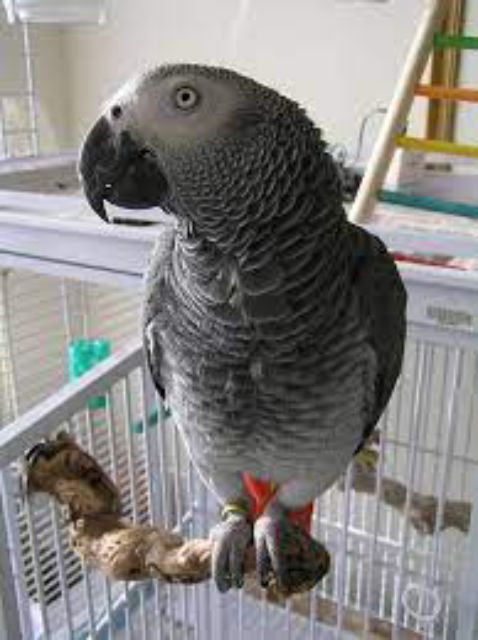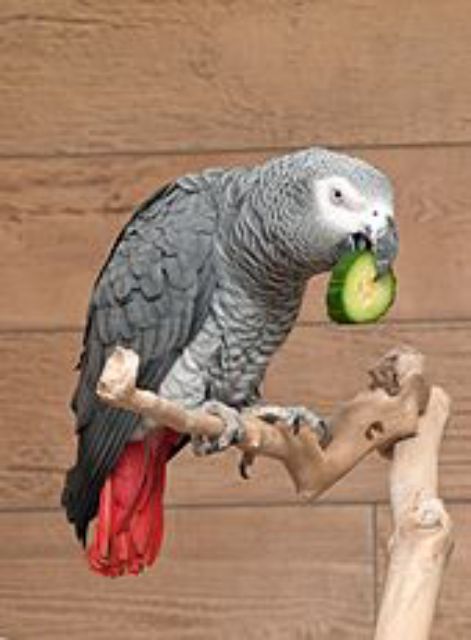When do you feed your African Grey? How much? Are supplements necessary? What size should your cage be? What kinds of toys are best? As the owner of an African Grey Parrot, you likely have a thousand questions about the proper care and feeding of your parrot. This article is devoted to breaking it down and making it easy for you to give your parrot the best.

African Grey Diet
The foundation of your African Grey’s diet should be pellets. Organic pellets are the best because they don’t introduce harmful chemicals into your bird’s diet. As the foundation of your parrot’s diet, they will make up approximately 65% of their daily nutrition and should not exceed 70%. So where does the remaining 30-35 percent come from?
Fresh fruits and veggies are imperative for a healthy bird. Many African Greys will have favorites, though it is important to offer a variety.

Common fruits and vegetables include Broccoli, spinach, apples, bananas, melon, oranges, berries, carrots, sweet peppers, and celery. Do not feed your African Grey avocados, caffeine, chocolate, or alcohol – they are toxic. Fruits and veggies will take up about 30% of your parrot’s diet. Always make sure to wash your fruits and veggies to remove pesticides.
The remaining 5%. These are the treats. The fun things you give your parrot when you’re interacting, training, or just want to offer a special reward. Seeds and nuts are the best treats and like fruits and veggies, your parrot will have favorites. Experiment and offer a variety to keep their diet well-rounded.
Supplements can be introduced, talk to your avian veterinarian first, to help reduce deficiencies. Common deficiencies are Vitamin A and calcium. Dark leafy greens are a good source of both vitamin A and calcium. Egg yolks are also a source of vitamin A.
Fresh water is an absolute must. Filtered water is best and needs to be replaced at least once a day. If you do not provide the correct diet it could lead to several problems with your grey.
African Grey Parrot Cage and Environment
While African Grey Parrots are not giant birds, they do deserve a large cage. The more room they have to move around, the happier they’ll be. The minimum sized cage for an African Grey is 18” W x 18” L x 30” tall.
Location, location, location… The optimal location for your parrot’s cage is against a wall or in the corner of the room you spend much of your time in. This accomplishes two things; your bird will not have to keep guard on all four sides of his cage additionally, he’ll be able to be part of the family even when he’s in his cage. Make sure your African Grey’s cage is in a well-lighted area free from drafts.
African Greys are too smart and well-behaved to be kept in their cages all day long. When you’re home, let them out. Give them a perch or play yard to hang out in.
Don’t forget the toys! Because African Greys are so intelligent, they need stimulation in the form of toys. Toys enable them to play, problem-solve, and experience a variety of textures, colors, sounds, and more.
Like fruits and veggies, your African Grey will have favorite toys and he’ll have toys he ignores completely. Introduce a variety of toys into your parrot’s life and keep an eye on the ones he likes to play with.
Cage materials are important too. Here are a few things to look for. Stainless steel is optimal. If it is out of your budget, then look for a steel cage coated with non-toxic paint. Make sure the bars are close enough together that your parrot cannot get out and that the door opens to the side or down like a drawbridge.
Square or rectangular cages are best – circular cages do not give your African Grey the room he needs to move around. If you plan on moving your cage at night, then look for one with wheels or locking casters. A wire bottom and a removable tray make cleaning quick and easy.
That’s it; those are the basics for caring for and feeding your African Grey. The best way to get started is to provide your parrot the basics and then pay attention to what they like and don’t like. To an African Grey, there’s nothing better than an attentive and engaged owner, an owner that cares.
